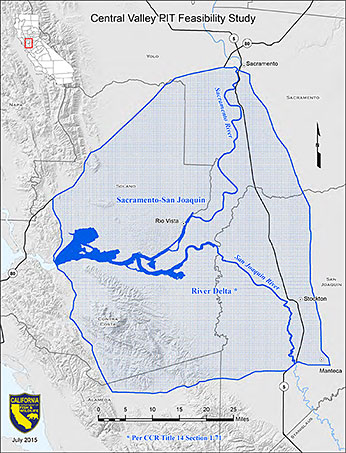(Bay-delta Waterways, Contra Costa, Sacramento, San Joaquin, Solano, and Yolo counties)
Species / Location
 (click/tap to enlarge)
(click/tap to enlarge)
California Central Valley Winter-run Chinook (endangered), Spring-run chinook (threatened), Steelhead (threatened), Green sturgeon (threatened), Longfin smelt (threatened) and Delta smelt (endangered) are many of the sensitive species affected by the compounding factors of the drought such as reduced water flows, sub optimal water quality, high temperatures and loss to unscreened water diversions. The ability to monitor fish movements and behaviors is critical to understanding impacts related to extreme climate conditions, water operations, and developing management strategies to minimize threats.
The National Marine Fisheries Service developed passive integrated transponder (PIT) tag technology during the 1980s (Prentice et al. 1990). PIT tags have become a primary method used to assess survival across various river reaches and inter-annual variability in survival associated with environmental conditions and system operations (e.g., Smith et al. 2002). This is due to the precision associated with the technology and survival estimates based on the technology. The data collected also supports development of life cycle models that identify scientific uncertainty, evaluate the effects of environmental conditions and anthropogenic actions on specific life stages, adjust stock management actions, and prioritize species recovery efforts.
Need for Program
The Governor’s Drought Executive Order issued April 25, 2014 directs the California Department of Fish and Wildlife to implement projects that respond to drought conditions through habitat restoration and through water infrastructure projects on property owned or managed by the Department of Fish and Wildlife or the Department of Water Resources for the benefit of fish and wildlife impacted by the drought. The Executive Order authorizes CDFW to enter into contracts to accomplish this work and implementation of these habitat restoration and water infrastructure projects.
This study will determine the feasibility of PIT-tag detection systems at key locations in the Bay-Delta waterways for proof-of-concept testing and estimate detection probabilities of the systems, with a long-term goal to establish permanent systems used to monitor fish behavior and help inform specific water and fishery management needs. If successful, this PIT-tag detection system for the Central Valley will support state and federal fisheries management decisions related to water resources, hydropower operations, aquatic resource habitat, hatchery operations, harvest management, and the recovery of species identified as needing protection under state and federal laws.
Monitoring & Research
There are three components of implementation: (1) preliminary concepts (2) engineering, and (3) application. Together, these three components will install and test systems at locations to develop site specific detection probabilities, design and test systems in more challenging open channel sites above and within the Delta to learn how to monitor the entire Delta in the future, and explore the feasibility of detecting fish entering the Delta from the Sacramento and San Joaquin rivers and leaving the Delta and entering the estuary/bay.
Future Efforts
Information provided from this feasibility project will determine if the use of PIT tag detection systems in the Bay-Delta waterways will provide valuable information for fisheries managers. This study was designed as an initial effort that can be expanded upon within and outside of the Delta in the future should the concepts prove feasible. The expanded system could include detection sites and fish releases in the upper Sacramento and San Joaquin river basins and key tributaries, and would be used to answer additional and more complex water and fish resource management questions.
Partners
- California Department of Fish and Game
- National Oceanic and Atmospheric Association
For additional information contact Jonathan Nelson, CDFW at Jonathan.Nelson@wildlife.ca.gov or Steve Lindley, NOAA at steve.lindley@noaa.gov
References
- Prentice, E.F., T.A. Flagg, and C.S. McCutcheon, 1990. Feasibility of using implantable passive integrated transponder (PIT) tags in salmonids. American Fisheries Society Symposium 7:317-322.
- Smith, S.G., W.D. Muir, J.G. Williams, and J.R. Skalski, 2002. Factors associated with travel time and survival of migrant yearling Chinook salmon and steelhead in the lower Snake River. North American Journal of Fisheries Management 22(2):385-405.
CDFW
NOAA